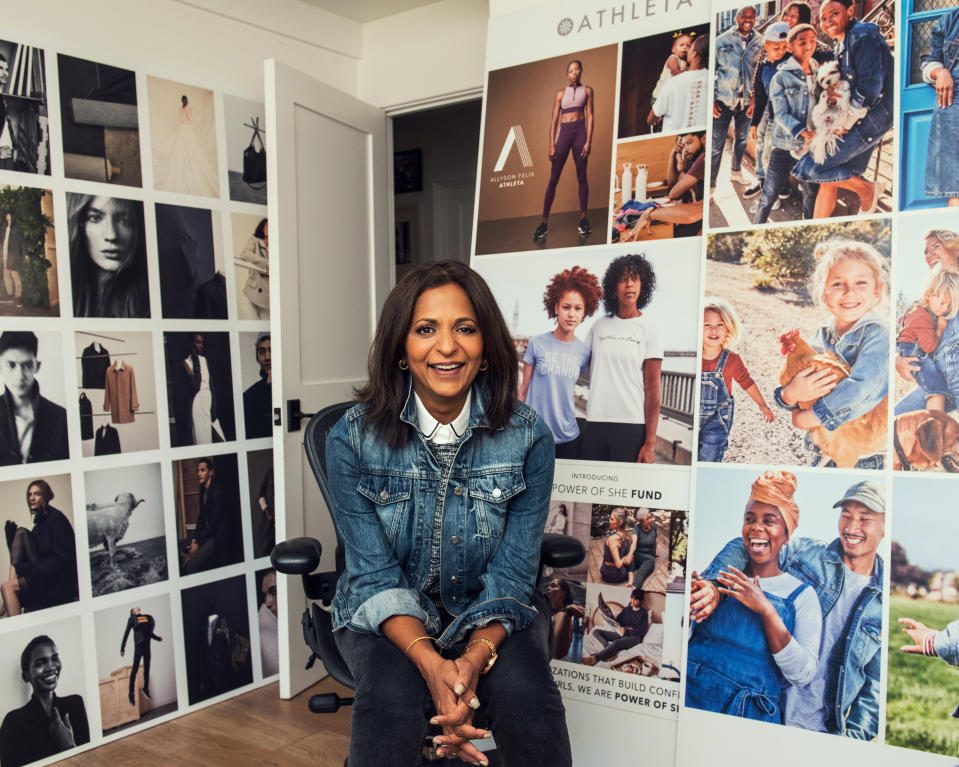Gap Inc. Issues Progress Report on Driving Equality and Change

Gap Inc. has released its first stand-alone “Equality and Belonging” report summarizing the company’s steps toward driving systemic change and racial and economic equality within its operations.
While Gap operates globally, the 21-page report primarily focuses on U.S. programs and activities between June 2020 and April 2021. Gap said it was a “stand-alone” report since previously the company reported people data within its sustainability reports issued since 2013.
More from WWD
“In 2020 — a year filled with disruption — we faced hard truths and, as a company, articulated our north star to be ‘Inclusive, by Design,'” Sonia Syngal, chief executive officer of Gap Inc., wrote in the report. “It will take all of us working together to create lasting change. We will devote all that is necessary because there is simply no exception to inclusion. With the launch of this inaugural report, I’m grateful to those who are leading our transformation — digging in every day and continually raising the bar to build a culture of belonging for all…”
“Gap, Inc. employing 76 percent women globally and 55 percent people of color in the U.S. has an opportunity to make a significant impact and work hand in hand with our employees, customers and community partners to help identify the critical intersection between racial equality, retail and government to create better outcomes for all,” Kisha Modica, Gap Inc.’s vice president of equality and belonging, wrote in the report.
“Last year, we publicly outlined our 2025 Equality & Belonging Commitments and began to lay the groundwork for a racial equality agenda,” Modica added. “It focuses on doing more to be a force for good, driving systemic change both inside and outside our walls, and enabling a culture of belonging for our teams, customers and communities. In the year that has passed since, we’ve remained steadfast in our approach to make space to listen, learn and dig deep by continuing our listening sessions, antiracism learning journey, internal and external community building and evaluating our culture and talent practices from ‘hire to retire.’”

The report indicates that Gap Inc., which operates the Gap, Old Navy, Banana Republic and Athleta brands, has, among other steps:
? Removed educational requirements for 99.7 percent of job descriptions below the vice president level to support workplace equity.
? Increased diversity in its rotational management program — 62 percent of employees in the program identify as Black, Indigenous and people of color, including 32 percent identified as Black and Latinx — nearly twice that of the 2020 class.
? The company is a founding member of the Second Chance Business Coalition through its partnership with Business Roundtable, which supports economic mobility for individuals and families of Black and brown communities, including a commitment to criminal justice reform.
? To facilitate “open and honest” conversations on topics such as systemic racism, unconscious bias, microaggressions, and the critical role of allyship, inclusion strategist Amber Cabral hosted nearly 40 sessions and workshops with employees, including a new global “Real Talk” series. The company has updated its employee learning curriculum to include mandatory racial equity training and the integration of inclusion and equity content in employee onboarding, new leader workshops, inclusive design courses, and a mentoring program.
? Gap has donated over $500,000 to Historically Black Colleges and Universities’ design departments to support educational infrastructure and scholarships in partnership with Harlem’s Fashion Row’s “Closing the Gap.”
? The Gap Collective, a collaborative featuring artists honoring moments such as Black History Month, has been created. Old Navy created Project We, a collection of limited-edition graphic Ts designed by diverse artists honoring cultural moments including Black History Month, International Women’s Day, Pride, Juneteenth, and Latinx Heritage Month.
? On the health front, Gap Inc. donated 3.5 million masks and face coverings to community organizations in response to COVID-19. For employees, the company offered a “Be Well + Stay Connected” speaker series of conversations focused on mental health and wellness through the pandemic.
“Our long-standing legacy of support for human rights and social causes is real and measurable, but we know there is more work to be done,” said Sheila Peters, chief people officer of Gap Inc. “This pivotal moment demands that we deepen our resolve and drive with even greater urgency — because we know that when inclusion isn’t optional, a new world of possibilities opens.”
Without providing specifics, the company indicated that it has aligned with several coalitions to increase opportunities for the Black community, ensure workplaces and stores are “welcoming” for everyone, and adopt standards that support and lead on issues for LGBTQ communities worldwide.
Since 2013, Gap Inc. has publicly reported its global employee gender data and overall U.S. race and ethnicity data. Starting in 2020, it began regularly sharing additional data on how employees identify their race and ethnicity at both the store and headquarters level.
However, based on data in the Equality and Belonging report, Gap Inc. remains an organization that has a long way to go to increase diversity in its ranks. The report said that the company’s San Francisco headquarters is 54 percent white; 26 percent Asian; 10 percent Latinx; 6 percent other, which includes Native American, and 4 percent Black.
Gap Inc.’s store leadership is 70 percent white; 17 percent Latinx; 9 percent Black; 3 percent Asian, and 1 percent other.
Store employees are 43 percent white; 27 percent Latinx; 19 percent Black; 6 percent Asian, and 5 percent other.
Globally, Gap Inc.’s workforce is 76 percent female and 24 percent male.
Sign up for WWD's Newsletter. For the latest news, follow us on Twitter, Facebook, and Instagram.
